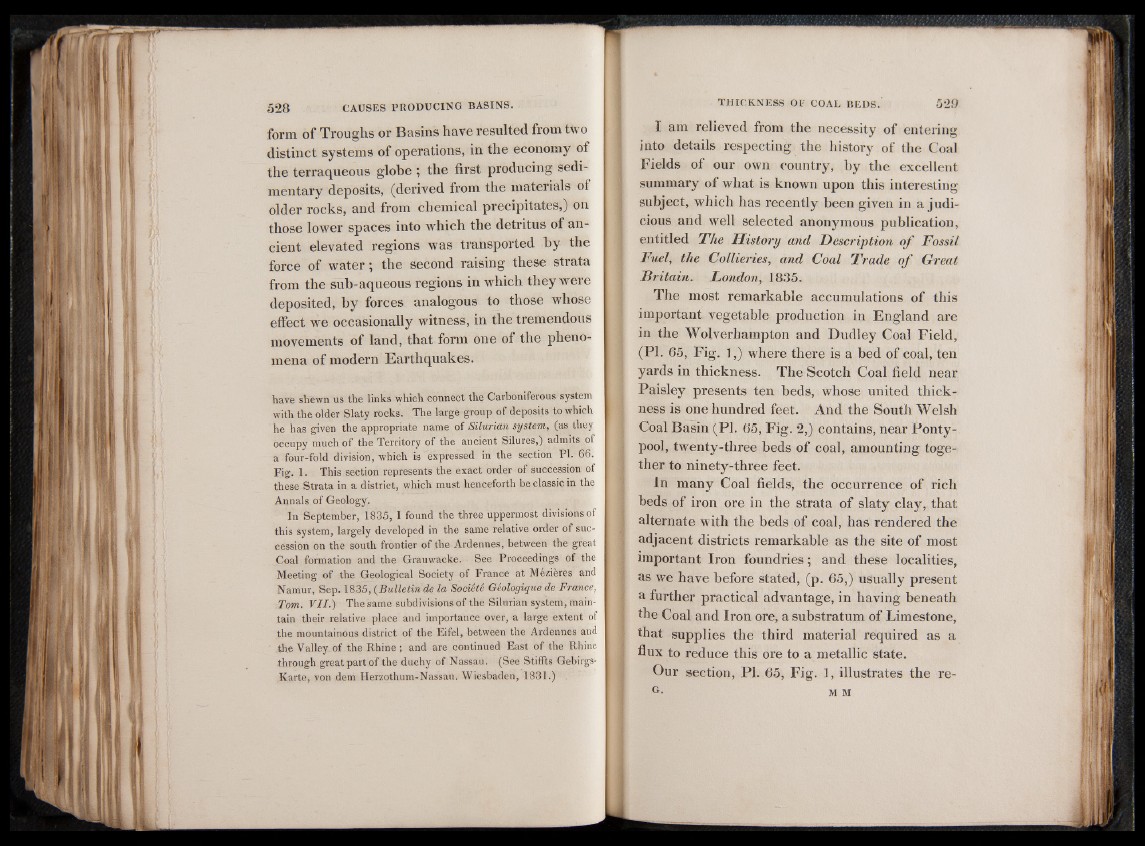
form of Troughs or Basins have resulted from two
distinct systems of operations, in the economy of
the terraqueous globe ; the first producing sedimentary
deposits, (derived from the materials of
older rocks, and from chemical precipitates,) on
those lower spaces into which the detritus of ancient
elevated regions was transported by the
force of water; the second raising these strata
from the sub-aqueous regions in which they were
deposited, by forces analogous to those whose
effect we occasionally witness, in the tremendous
movements of land, that form one of the phenomena
of modern Earthquakes.
have shewn us the links which connect the Carboniferous system
with the older Slaty rocks. The large group of deposits to which
he has given the appropriate name of Silurian system, (as they
occupy much of the Territory of the ancient Silures,) admits of
a four-fold division, which is expressed in the section PL 66.
Fig. 1. This section represents the exact order of succession of
these Strata in a district, which must henceforth be classic in the
Annals of Geology.
In September, 1835, I found the three uppermost divisions of
this system, largely developed in the same relative order of succession
on the south frontier of the Ardennes, between the great
_Coal formation and the Grauwacke, See Proceedings of the
Meeting of the Geological Society of France at Mézières and
Namur, Sep. 1835, (Bulletin de la Société Géologique de France,
Tom. VII.) The same subdivisions of the Silurian system, maintain
their relative place and importance over, a large extent of
the mountainous district of the Eifel, between the Ardennes and
the Valley of the Rhine ; and are continued East of the Rhine
through great part of the duchy of Nassau. (See Stiffts Gebirgs-
Karte, von dem Herzothum-Nassau. Wiesbaden, 1831.)
I am relieved from the necessity of entering
into details respecting the history of the Coal
Fields of our own country, by the excellent
summary of what is known upon this interesting
subject, which has recently been given in a judicious
and well selected anonymous publication,
entitled The History and Description of Fossil
Fuel, the Collieries, and Coal Trade of Great
Britain. London, 1835.
The most remarkable accumulations of this
important vegetable production in England are
in the Wolverhampton and Dudley Coal Field,
(PI. 65, Fig. 1,) where there is a bed of coal, ten
yards in thickness. The Scotch Coal field near
Paisley presents ten beds, whose united thickness
is one hundred feet. And the South Welsh
Coal Basin (PI. 65, Fig. 2,) contains, near Ponty-
pool, twenty-three beds of coal, amounting together
to ninety-three feet.
In many Coal fields, the occurrence of rich
beds of iron ore in the strata of slaty clay, that
alternate with the beds of coal, has rendered the
adjacent districts remarkable as the site of most
important Iron foundries; and these localities,
as we have before stated, (p. 65,) usually present
a further practical advantage, in having beneath
the Coal and Iron ore, a substratum of Limestone,
that supplies the third material required as a
flux to reduce this ore to a metallic state.
Our section, PI. 65, Fig. 1, illustrates the re-
G. M M